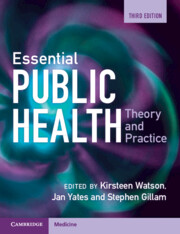Book contents
- Essential Public Health
- Essential Public Health
- Copyright page
- Contents
- Contributors
- Foreword
- Acknowledgements
- Introduction
- Part 1 The Public Health Toolkit
- Part 2 Contexts for Public Health Practice
- Introduction to Part 2: What Do We Mean by Contexts in Public Health?
- 11 The Health of Children and Young People
- 12 Adult Public Health and Non-Communicable Diseases
- 13 Public Health and Ageing
- 14 Health Inequalities and Public Health Practice
- 15 Health Policy
- 16 International Development and Public Health
- 17 Planetary Health
- Glossary
- Index
- References
17 - Planetary Health
from Part 2 - Contexts for Public Health Practice
Published online by Cambridge University Press: 01 December 2023
- Essential Public Health
- Essential Public Health
- Copyright page
- Contents
- Contributors
- Foreword
- Acknowledgements
- Introduction
- Part 1 The Public Health Toolkit
- Part 2 Contexts for Public Health Practice
- Introduction to Part 2: What Do We Mean by Contexts in Public Health?
- 11 The Health of Children and Young People
- 12 Adult Public Health and Non-Communicable Diseases
- 13 Public Health and Ageing
- 14 Health Inequalities and Public Health Practice
- 15 Health Policy
- 16 International Development and Public Health
- 17 Planetary Health
- Glossary
- Index
- References
Summary
The gross injustice of environmental change, with those who have polluted the least suffering the biggest consequences, is becoming more apparent. Society is not responding at the scale and pace required to avoid catastrophic loss of life, but from courtrooms to the streets changes are emerging. In this context, public health is now practised. Public health skills, knowledge and attitudes are essential to creating a more sustainable and fairer world.
This chapter defines key terms, describes some of the most important environmental transitions, challenges and opportunities, and considers what our public health response to these can be. It seeks to equip the reader with some basic knowledge and all-important motivation for becoming a more effective agent for change at a time when planetary health must become everyone’s business.
Keywords
- Type
- Chapter
- Information
- Essential Public HealthTheory and Practice, pp. 323 - 338Publisher: Cambridge University PressPrint publication year: 2023



